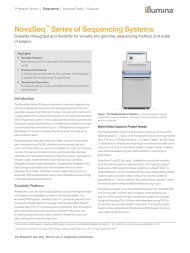Abstracts
ngsfinalprogram
ngsfinalprogram
You also want an ePaper? Increase the reach of your titles
YUMPU automatically turns print PDFs into web optimized ePapers that Google loves.
Poster <strong>Abstracts</strong><br />
to Salmonella to evaluate metagenomics as<br />
a diagnostic and disease surveillance tool, as<br />
well as to gain insight into the gut microbial<br />
community responses to foodborne bacterial<br />
infection. These outbreaks were geographically<br />
isolated and the etiologic agents were<br />
identified by culture methods as distinct strains<br />
of Salmonella enterica serovar Heidelberg.<br />
We performed shotgun sequencing on these<br />
samples using the Illumina MiSeq platform.<br />
Community and taxonomic analysis were<br />
performed using Parallel-META, Metaphlan,<br />
and GOTTCHA. Subspecies analysis was<br />
performed using BLAST recruitment analysis.<br />
Further phylogenetic analysis was performed<br />
on metagenomic assemblies of samples and<br />
resulting contigs matching S. enterica. Results:<br />
Sample consistency and human DNA<br />
sequence abundance varied greatly, often<br />
reducing the sequencing depth of the targeted<br />
microbial communities, yet referenced-based<br />
detection of Salmonella serovar Heidelberg<br />
was possible by metagenomic read recruitment<br />
as well as metagenomic assembly, even in<br />
samples with high human DNA content (90-<br />
96%). Taxonomic profiling revealed similar<br />
microbial community structures between individual<br />
patients from each localized outbreak;<br />
samples from different outbreaks clustered<br />
separately and were distinct from a subset of<br />
‘healthy’ references selected from the Human<br />
Microbiome Project. Microbial gut communities<br />
consistently showed reduced species<br />
diversity in each foodborne outbreak compared<br />
to ‘healthy’ references. Conclusions: These<br />
results highlight the potential utility of metagenomic-based<br />
diagnostic tools for foodborne<br />
pathogen identification and epidemiologically<br />
relevant clustering, even in samples with high<br />
human DNA abundance. Furthermore, shotgun<br />
metagenomic approaches offer additional insight<br />
into gut microbial community responses<br />
to foodborne illness that may hold clues to<br />
pathogen ecology.<br />
n 74<br />
INTEGRATING WHOLE GENOME<br />
SEQUENCING OF SALMONELLA ENTERICA<br />
SEROVAR ENTERITIDIS INTO THE PUBLIC<br />
HEALTH LABORATORY FOR SURVEILLANCE<br />
AND OUTBREAK INVESTIGATIONS<br />
K. J. Levinson 1 , M. Dickinson 2 , S. Wirth 2 , M.<br />
Anand 3 , D. J. Baker 2 , D. Bopp 2 , L. Thompson 2 ,<br />
K. A. Musser 2 , P. Lapierre 2 , W. J. Wolfgang 2 ;<br />
1<br />
School of Public Health, SUNY Albany,<br />
Albany, NY, 2 Wadsworth Center/NYSDOH,<br />
Albany, NY, 3 Bureau of Communicable Disease<br />
Control/NYSDOH, Albany, NY.<br />
Salmonella enterica serovar Enteritidis is<br />
a leading cause of foodborne illness in the<br />
United States. Pulsed-field gel electrophoresis<br />
(PFGE) is the gold standard for outbreak detection<br />
of enteric pathogens. However, the low<br />
genetic diversity of S. Enteritidis and frequent<br />
exchanges of mobile genetic elements limits<br />
how well PFGE can discriminate between<br />
isolates and identify clusters that may be<br />
epidemiologically linked. Two-thirds of all S.<br />
Enteritidis isolates received at the Wadsworth<br />
Center have PFGE patterns that are considered<br />
“endemic” and over half of these are pattern<br />
JEGX01.0004. Consequently, these cases<br />
are not routinely investigated by epidemiologists.<br />
To improve discrimination between<br />
sporadic and outbreak associated isolates, the<br />
Wadsworth Center began performing whole<br />
genome sequencing (WGS) single nucleotide<br />
polymorphism (SNP) based phylogenetic typing<br />
on all S. Enteritidis isolates in addition to<br />
PFGE typing. The goal of this project was to<br />
explore the utility of incorporating WGS-based<br />
typing into routine public health laboratory<br />
surveillance and to establish a standard for reporting<br />
WGS data in a manner that was useful<br />
for both laboratorians and epidemiologists. Using<br />
a pipeline developed in-house, we created<br />
cumulative SNP based phylogenetic trees from<br />
514 S. Enteritidis isolates in real time over a<br />
period of 20 months. Based on retrospective<br />
studies, we used a SNP diversity of 0-5 to de-<br />
ASM Conference on Rapid Next-Generation Sequencing and Bioinformatic<br />
Pipelines for Enhanced Molecular Epidemiologic Investigation of Pathogens<br />
89



